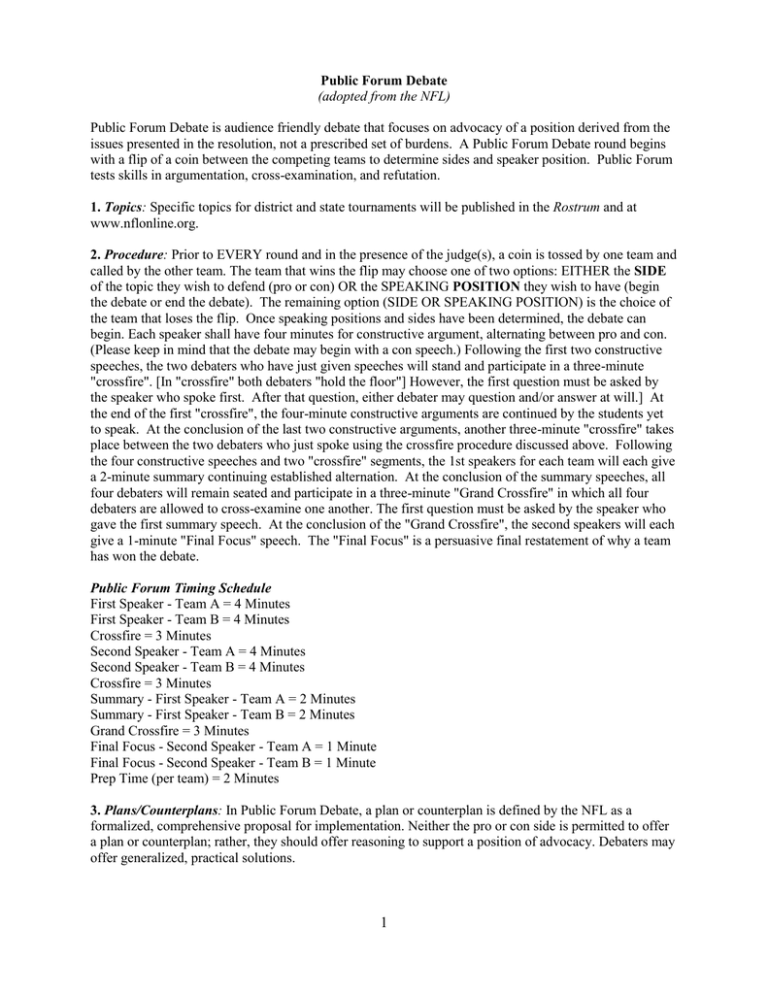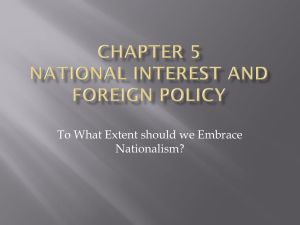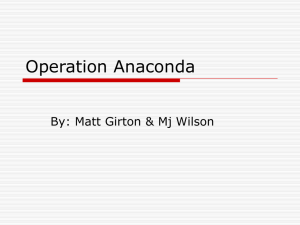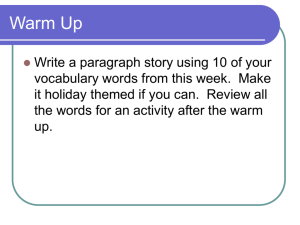Public Forum Overview - Columbia High Wildcat Forensics
advertisement

Public Forum Debate (adopted from the NFL) Public Forum Debate is audience friendly debate that focuses on advocacy of a position derived from the issues presented in the resolution, not a prescribed set of burdens. A Public Forum Debate round begins with a flip of a coin between the competing teams to determine sides and speaker position. Public Forum tests skills in argumentation, cross-examination, and refutation. 1. Topics: Specific topics for district and state tournaments will be published in the Rostrum and at www.nflonline.org. 2. Procedure: Prior to EVERY round and in the presence of the judge(s), a coin is tossed by one team and called by the other team. The team that wins the flip may choose one of two options: EITHER the SIDE of the topic they wish to defend (pro or con) OR the SPEAKING POSITION they wish to have (begin the debate or end the debate). The remaining option (SIDE OR SPEAKING POSITION) is the choice of the team that loses the flip. Once speaking positions and sides have been determined, the debate can begin. Each speaker shall have four minutes for constructive argument, alternating between pro and con. (Please keep in mind that the debate may begin with a con speech.) Following the first two constructive speeches, the two debaters who have just given speeches will stand and participate in a three-minute "crossfire". [In "crossfire" both debaters "hold the floor"] However, the first question must be asked by the speaker who spoke first. After that question, either debater may question and/or answer at will.] At the end of the first "crossfire", the four-minute constructive arguments are continued by the students yet to speak. At the conclusion of the last two constructive arguments, another three-minute "crossfire" takes place between the two debaters who just spoke using the crossfire procedure discussed above. Following the four constructive speeches and two "crossfire" segments, the 1st speakers for each team will each give a 2-minute summary continuing established alternation. At the conclusion of the summary speeches, all four debaters will remain seated and participate in a three-minute "Grand Crossfire" in which all four debaters are allowed to cross-examine one another. The first question must be asked by the speaker who gave the first summary speech. At the conclusion of the "Grand Crossfire", the second speakers will each give a 1-minute "Final Focus" speech. The "Final Focus" is a persuasive final restatement of why a team has won the debate. Public Forum Timing Schedule First Speaker - Team A = 4 Minutes First Speaker - Team B = 4 Minutes Crossfire = 3 Minutes Second Speaker - Team A = 4 Minutes Second Speaker - Team B = 4 Minutes Crossfire = 3 Minutes Summary - First Speaker - Team A = 2 Minutes Summary - First Speaker - Team B = 2 Minutes Grand Crossfire = 3 Minutes Final Focus - Second Speaker - Team A = 1 Minute Final Focus - Second Speaker - Team B = 1 Minute Prep Time (per team) = 2 Minutes 3. Plans/Counterplans: In Public Forum Debate, a plan or counterplan is defined by the NFL as a formalized, comprehensive proposal for implementation. Neither the pro or con side is permitted to offer a plan or counterplan; rather, they should offer reasoning to support a position of advocacy. Debaters may offer generalized, practical solutions. 1 Public Forum PRO Arguments Although imperfect, NATO’s presence is necessary to prevent Taliban control “Without American and NATO forces in Afghanistan, the Taliban can easily topple the Afghan government. It would be ethically wrong to give up Afghanistan to the Taliban, a force both ideologically rigid and blind, as well as politically violent in nature. The Talibani movement believes in violence especially against non-Muslims without recognizing or respecting any international human rights norms, including the right to education for women, and they believe in establishing a government which rules through force. Leaving Afghanistan to such a rigid ideology and violent force is unethical. If the Taliban takes hold of power in Afghanistan, its gross human rights violations will soon shame the United States and the international community. (Foreign Policy Association, September 2010) IMPACT: NATO is not responsible for the majority of Afghan casualties. “The vast number of civilian casualty incidents were caused by the Taliban and other insurgent groups. United Nations investigations show that in 2009 "anti-government elements" were responsible for the deaths of two-thirds of the civilians killed, 1630 out of a total of 2412. The Taliban and other insurgent groups conduct intentional and indiscriminate attacks against civilians and using civilians as human shields in violation of the laws of war.” (Human Rights Watch) IMPACT: NATO is bringing development and assistance to Afghan citizens. “The notion of war, rightly or not, is still in place, however it is no longer entirely based on vigorous armies and resources, but on socio economic development freedoms as well. Maintaining security as the goal, NATO members participate in individual and collective defense strategies from the ‘traditional notions’ of war to development programs. United States and Canada, among other NATO allies, have taken the appropriate steps to promote human rights in Afghanistan.” (World Poverty & Human Rights 3/27/2010) For example, the “California Army National Guard's 40th Infantry Division have deployed to [an] isolated, mountainous section of Afghanistan to win the hearts and minds of rural Afghans by helping them improve their farming methods and livestock management. Seven National Guard units from farm states are now in Afghanistan doing similar work. In military terms, it's a "non-kinetic" mission, which means the main goal is not to kill the enemy but to bond an uncertain populace with its local government, which is assisting in the vaccination program.” (Los Angeles Times, 12/21/09) IMPACT: 2 Public Forum CON Arguments NATO kills & wrongly harms innocent Afghan citizens According to Dr. Mark Herold, “What causes the documented high level of civilian casualties -- 3,000 3,400 civilian deaths -- in the U.S. air war upon Afghanistan? The explanation is the apparent willingness of U.S. military strategists to fire missiles into and drop bombs upon, heavily populated areas of Afghanistan. Current Afghan civilian lives must and will be sacrificed in order to [possibly] protect future American lives. The U.S. is seeking to inflict maximum pain upon Afghan society and perceived 'enemies': the targeted bombing of the Kajakai dam and other power stations, radio stations, the Kabul telephone exchange, the Al Jazeera Kabul office, trucks and buses filled with fleeing refugees, and the numerous attacks upon civilian trucks carrying fuel oil. Indeed, the bombing of Afghan civilian infrastructure parallels that of the Afghan civilian.” (Dr. Marc W. Herold, Whitmore School of Business and Economics) “A United Nations report released in August revealed the number of innocent Afghans killed or injured in the last six months increased dramatically by 31 percent compared to the first half of 2009. The number of children killed or injured reached 565, increasing 55 percent this year. 2010 has been the bloodiest year with more than 3,268 have been killed or injured thus far.” (Foreign Policy Association, September 2010) IMPACT: If anything, the civilian deaths from NATO forces are underestimated. “Leaked documents contain incidents of civilian deaths and injuries during combat operations that previously were not publicly acknowledged by US or NATO forces. After an August 2008 airstrike in Herat province, the US and NATO initially reported that only five to seven civilians were killed, a figure that was included in spot reports among the leaked data. The US and NATO publicly rejected separate investigations conducted by the United Nations, the Afghan government, and the Afghan Independent Human Rights Commission, which concluded that 78 to 92 civilians had been killed, the majority of them women and children.” (Human Rights Watch) IMPACT: NATO is not winning a military victory “The military surge of an additional 30,000 troops by the Obama administration has not succeeded in preventing the Taliban from aggressively controlling more territory, using more roadside bombs against NATO forces and orchestrating a rise in suicide bombings and assassination operations. Furthermore, the NATO operation in Marjah this year did not produce the desired outcome of rooting out the Taliban from this opium producing district in Helmand province. The Kandahar offensive, which was planned to bring this southern region under the control of the Afghan government, was postponed.” (Foreign Policy Association, September 2010) 3 IMPACT: NATO should be focused on nation-building to help civilians “What Afghanistan needed from the time of the American and NATO invasion was the building of an infrastructure and viable economy. Instead, the United States war strategy was geared toward military operation against terrorism. Once again, Afghanistan became a war zone for military operations, not generating considerable attention in the arena of nation-building of the economy, infrastructure, education and politics. Extensive NATO military operations damaged the support that the country needed from its own population in an effort to eradicate Taliban from the politics of this nation. The president of Pakistan, Asif Ali Zardari, said,” I believe that the international community, is in the process of losing the war against Taliban and that is, above all, because we have lost the battle for hearts and minds.”” (Foreign Policy Association, September 2010) IMPACT: NATO is not meeting its goal of training the Afghan police and military In a New York Times article titled, NATO Falls Far Short of Helping Afghans, it was reported that, “NATO acknowledged that it lacked almost half the trainers it had promised to help build up the army and police in Afghanistan.” (February 4, 2010) IMPACT: 4 Public Forum Debate Pro Case Outline Before you begin your speech briefly thank the judge and your opponent for providing the opportunity for this important debate. I. Engage With an Attention-Getter. The attention-getter is designed to intrigue the audience members and to motivate them to listen attentively for the next several minutes. There are infinite possibilities for attention-getting devices. Some of the more common devices include using a story, a surprising statistic, or a quotation. Whichever you choose, be sure that your attention-getter makes sense to the case and that it is explained. II. Provide Resolutional Analysis. Say the precise wording of the topic so your judge knows exactly what is being debated. Provide a thesis and preview your main arguments and why the topic is important (ex. Thesis: “Antibiotic resistant bacteria are a serious threat that must be addressed immediately. Preview: “Today my partner and I will first, introduce you to a series of drug resistant super bugs and second, we will establish the cause of this life threatening trend. Through this examination you will agree that immediate action is needed to stop the growth of drug resistant super bugs.”) III. Offer Definitions. Clearly define the vital words/phrases in the resolution and cite the dictionary or encyclopedia you used. Make sure the definitions you choose support what you are arguing – definitions matter – sometimes they decide who wins and loses the debate! IV. Present Contention 1. Provide a “tagline” or brief title to the argument. Introduce the claim or argument you are making (ex. “Capital punishment deters crime”). Introduce your warrant - the reason your claim is true. Offer valid evidence that supports your claim (ex. “According to the Attorney General, states that have the death penalty have less violent crime”). Explain the impact of your argument on the debate. Be sure to relate your argument back to the resolution (ex. “Because capital punishment decreases crime it should continue to be used in the United States to keep innocent citizens safe”). V. Present Contention 2. Is the claim clear? Is valid evidence offered? Is the warrant clear? (Is the piece of evidence explained, how does it apply to the resolution?) Is enough evidence offered to prove the claim? VI. Present Contention 3. (optional, if time allows) Same structure as Contention 1 and 2 above! VII. End the Speech with a Solid Conclusion. Review the main points of the case – summarize the gist of your case for the judge. Provide a final thought that refers back to the attention-getter. Ask for the win (ex. “For all these reasons, I can see nothing but a ballot in support of capital punishment”). 5 Public Forum Debate Con Case Outline Before you begin your speech briefly thank the judge and your opponent for providing the opportunity for this important debate. I. Engage With an Attention-Getter. The attention-getter is designed to intrigue the audience members and to motivate them to listen. Some of the more common devices include using a story, a surprising statistic, or a quotation. II. Provide a Resolutional Analysis. Repeat the precise wording of the topic so your judge knows exactly what is being debated. Provide a thesis and preview your main arguments and why the topic is important. III. Offer Definitions. Provide definition for terms you think may be unclear. If the pro offered fair definitions it is ok to accept their definitions. You should say, “The pro has provided fair definitions, I see no need to redefine”. However, if you need to change some of them say – “I would like to redefine the following words…” If you redefine, be sure to tell the judge why your definition is better (Ex. Your definition is from a better source; your definition is more commonly accepted, etc.). If your opponents did not offer definitions, or if you go first, you should offer definitions for the resolution. IV. Present Contention 1. Provide a “tagline” or brief title to the argument. Introduce the claim or argument you are making (ex. “Capital punishment deters crime”). Introduce your warrant - the reason your claim is true. Offer valid evidence that supports your claim (ex. “According to the Attorney General, states that have the death penalty have less violent crime”). Explain the impact of your argument on the debate. Be sure to relate your argument back to the resolution (ex. “Because capital punishment decreases crime it should continue to be used in the United States to keep innocent citizens safe”). V. Present Contention 2. Is the claim clear? Is valid evidence offered? Is the warrant clear? (Is the piece of evidence explained, how does it apply to the resolution?) Is enough evidence offered to prove the claim? VI. Present Contention 3. Is the claim clear? Is valid evidence offered? Is the warrant clear? (Is the piece of evidence explained, how does it apply to the resolution?) Is enough evidence offered to prove the claim? VII. Attack Your Opponent’s Case. As the con in PF debate, you are responsible for clashing with the pro case as well as presenting your own case against the resolution. This makes your first constructive speech very important as it both establishes your position and finds fault with the pro case. To clash with the pro case you should go through each of their contentions and explain why they are flawed. VII. End the Speech with a Solid Conclusion. 6








